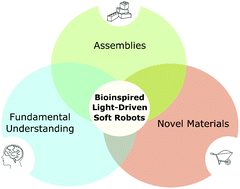Bioinspired light-driven soft robots based on liquid crystal polymers
Abstract
Nature is a constant source of inspiration for materials scientists, fueling the dream of mimicking life-like motion and tasks in untethered, man-made devices. Liquid crystalline polymers (LCPs) programmed to undergo three-dimensional shape changes in response to light are promising materials for fulfilling this dream. The successful development of autonomous, highly controlled light-driven soft robots calls for an understanding of light-driven actuation, advancements in material function and performance, and progress in engineering principles for transforming actuation into life-like motions, from simple bending to walking, for example. This tutorial review includes an introduction to liquid crystal (LC)-based materials and highlights developments in light-responsive LC polymers, shape programmability and sustained motions to finally achieve bioinspired untethered soft robots able to perform locomotion and tasks.



 Please wait while we load your content...
Please wait while we load your content...